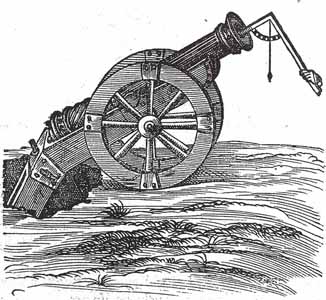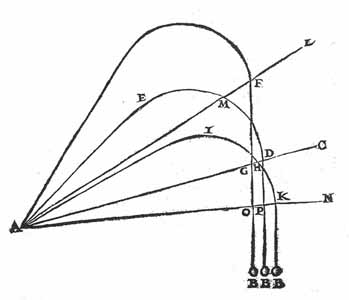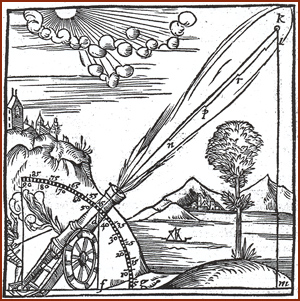The
English mathematician Thomas Harriot is best known
for accomplishments
in three areas.
* Navigation
|
* Astronomy
|
* Algebra
|
We
now investigate his models of projectile motion;
specifically,
determining the path of a cannon or mortar shot.
|
Harriot’s
first model (above) predicted the
paths traced in red for shots fired
at elevation angles of 30, 45, and 60
degrees. Each of these
paths has the same maximum height and,
as the elevation angle
decreases, the range increases.
Harriot’s final model, predicting
the curves traced in blue, was much
more realistic. This model
matches both reality and the curves
predicted by classical mechanics
very well.
Harriot's
patron, Sir Walter Raleigh, sent
Harriot on a voyage to the New World
in 1585. Harriot lived in what
is now North Carolina for one year
before sailing back to England with
Sir Francis Drake in 1586. He
wrote a book about his experiences
called "A Briefe and True Report of
the New Found Land of Virginia" that
was translated into many languages.
Beginning
in July of 1609, Harriot made drawings
of the moon, as observed through
his brand-new telescope. This
was five months before Galileo
would do the same and gain much
greater recognition for it.
|
|
Earlier
contributions from
Tartaglia's "Nova scientia . . ." (1537):
|
Harriot
on
Projectile Motion: The
Cannon Shot
Harriot's starting point was the
medieval
belief, presented in the gunnery manuals of
his time, that the flight
of the cannonball began with "violent motion"
out of the muzzle of the
gun and ended with "natural motion" as it fell
to the ground.
Anyone who had seen a cannon or mortar shot
knew that the motion did
not abruptly change from one to the other, but
rather made a more
gradual transition from "violent" to "natural"
motion during a period
of "mixed" motion.
Harriot would construct cannonball curves by
plotting points marking
the cannonball's position in the air after
equal intervals of time, and
then drawing a smooth curve connecting the
points. By taking into
account both motion in the direction of the
shot and motion straight
downwards due to gravity, he would combine
"violent" and "natural"
motion into smooth curves.
|
|
How
realistic are Harriot's First
Models?
Study
the above curves. The shape for a
shot at an elevation angle of
30 to 60 degrees is fairly
realistic. However, you can see
already that all trajectories seem to have
the same height and that the
range of the shot increases as the
elevation angle decreases.
|
Harriot's Final Models |
| * Motion
in the direction of the shot decelerates according
to the sequence 15,
13, 11, 9, 7, 5, 3, 1 |
* Vertical
motion accelerates downward according to the
sequence 1, 3, 5, 7, 9,
11, 13, 15
|
Angle
of 30
degrees
|
Angle
of 45
degrees
|
Angle
of 60 degrees
|
|

 2010
2010




